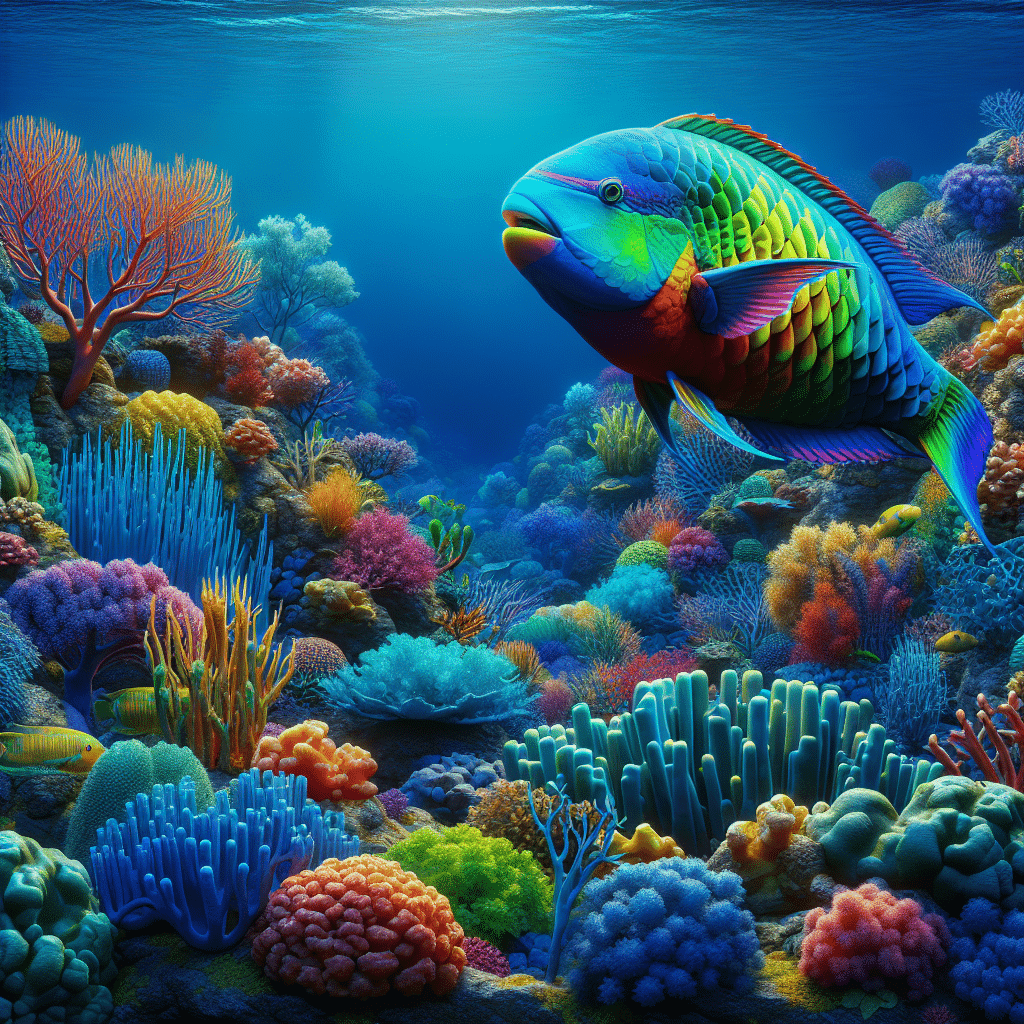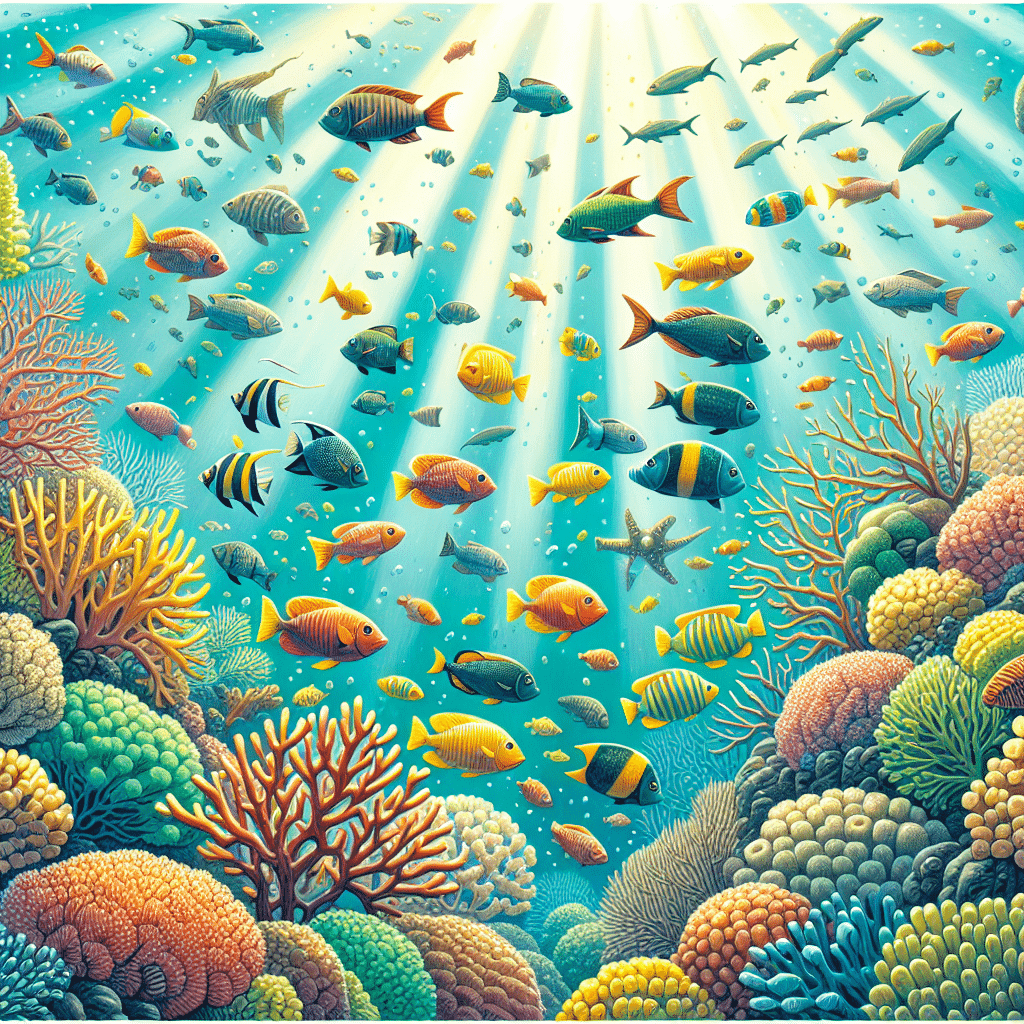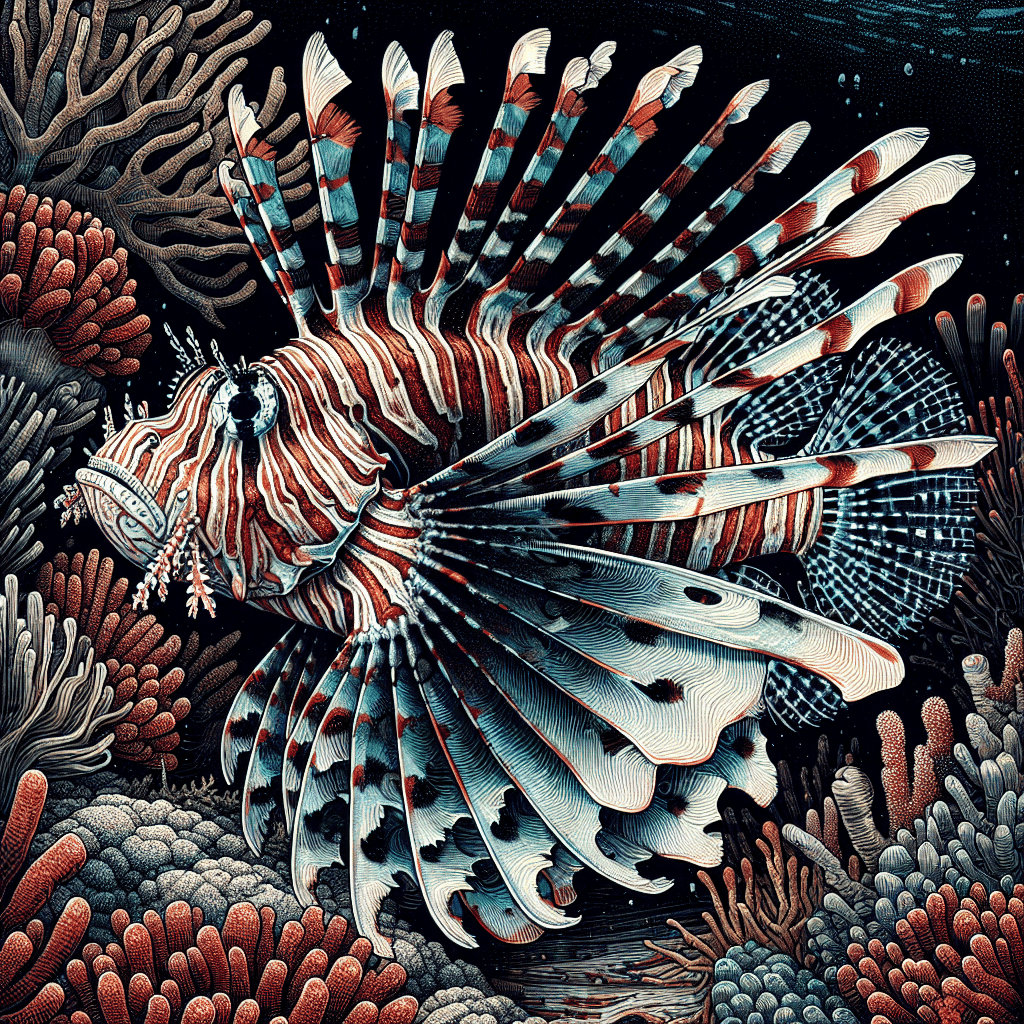Parrotfish: The Reef Guardians
Introduction to Parrotfish
I find parrotfish to be one of the most fascinating inhabitants of coral reefs. These vibrant, colorful fish aren’t just beauty in the ocean; they play crucial roles in maintaining the health of reef ecosystems. Named for their distinctive beak-like mouths, parrotfish are known for their unique feeding habits and significant contributions to their environments. They are often seen grazing on algae and coral, which brings me to their remarkable teeth.
Unique Teeth of Parrotfish
The teeth of parrotfish are truly something special. They have about 1,000 teeth lined up in 15 rows, cemented together to form a sturdy beak structure. This setup allows them to bite into hard coral with ease. Unlike most fish, these teeth are made of fluorapatite, which is the second-hardest biomineral in the world. This strength is vital, as it enables parrotfish to withstand the high pressure they encounter while grazing on rocky substrates.
Parrotfish use their beak-like mouths to rasp algae off the coral and other surfaces. This unique dentition contributes to bioerosion, a process that helps shape the reef environment. The teeth not only assist in feeding but also allow parrotfish to grind down coral into sand, an essential part of beach ecosystems.
Here’s a quick look at some interesting facts about parrotfish teeth:
| Feature | Description |
|---|---|
| Number of Teeth | Approximately 1,000 teeth |
| Arrangement | 15 rows arranged in a tightly packed mosaic |
| Material | Fluorapatite (second-hardest biomineral) |
| Function | Rasping algae and grinding coral |
These unique adaptations make parrotfish essential for coral reef health and maintenance. If you’re interested in learning more about marine fish, don’t forget to check out other fascinating species like tangs and triggerfish.
Parrotfish Species
When diving into the world of parrotfish, there are some fascinating size variations and a diverse habitat worth exploring.
Size Variations
Parrotfish come in various sizes, ranging from the small bluelip parrotfish to the massive green humphead parrotfish. Here’s a quick look at some notable species and their maximum sizes:
| Parrotfish Species | Maximum Size (cm) | Maximum Size (in) |
|---|---|---|
| Bluelip Parrotfish | 13 | 5.1 |
| Green Humphead Parrotfish | 130 | 51.2 |
The bluelip parrotfish, at only 13 cm, is the smallest species, while the green humphead parrotfish can grow up to an impressive 1.3 meters. This size variation makes parrotfish a fascinating group for any aquarium enthusiast.
Habitat and Distribution
Parrotfish are found in tropical and subtropical regions worldwide. They typically inhabit shallow waters near coral reefs, where they play an essential role in maintaining the ecosystem. Parrotfish feed on algae, detritus, and dead coral pieces, using their strong, beak-like teeth to graze on algal growth or remove unhealthy coral sections.
These fish are active during the day, often seen cleaning algae off coral colonies, which allows the algae within the coral to thrive through photosynthesis. At night, they burrow in the sand or hide in crevices to rest.
Understanding the habitat and behavior of parrotfish can help me create a more balanced and healthy reef tank. If you’re interested in other marine species that can complement a parrotfish setup, check out marine fish like tangs or clownfish.
Role of Parrotfish in Reef Ecosystems
Parrotfish play a vital role in the health and maintenance of reef ecosystems. Their unique feeding habits and behaviors contribute significantly to the overall balance of marine life.
Sand Production
One of the most fascinating aspects of parrotfish is their contribution to sand production. By feeding on coral and algae, they help break down calcium carbonate, which is a major component of coral skeletons. This process results in the creation of fine sand, essential for beach formation and the overall health of the reef environment. For instance, the humphead parrotfish can produce around 90 kg (200 lb) of sand each year, which amounts to approximately 250 g (9 oz) per parrotfish daily (Wikipedia).
| Parrotfish Species | Sand Production (kg/year) |
|---|---|
| Humphead Parrotfish | 90 |
| Other Species | Varies |
Algae Grazing
Parrotfish are the unsung heroes of algae control on coral reefs. They graze on algal overgrowth, which is crucial for preventing these algae from suffocating corals. By consuming turf and fleshy seaweeds, parrotfish help maintain the balance between algal producers and coral reefs. Their grazing not only clears the way for healthy coral growth but also prevents harmful algal blooms that can devastate reef ecosystems (ScienceDirect).
Coral Health Maintenance
Beyond just grazing on algae, parrotfish actively contribute to the maintenance of coral health. They break off dead or unhealthy coral sections, preventing disease spread and allowing space for new growth. Their ability to consume older coral pieces is essential for fostering a thriving reef ecosystem. This recycling of coral debris also creates habitats for smaller organisms and aids in coral reproduction.
In summary, parrotfish are not just colorful inhabitants of the reef but essential players in maintaining its health. Their roles in sand production, algae grazing, and coral health maintenance highlight the importance of protecting these incredible fish to ensure the sustainability of reef ecosystems. If you’re interested in more marine fish, check out our section on marine fish.
Threats to Parrotfish Populations
Parrotfish play a crucial role in maintaining healthy reef ecosystems, but they face several threats that jeopardize their populations. As someone who’s passionate about reef tanks and the fish that inhabit them, it’s essential to recognize these issues.
Overfishing
Overfishing is a significant threat to parrotfish populations. These fish are often considered delicacies in many cultures, leading to increased fishing pressure. The decline in parrotfish numbers has been identified as one of the major drivers of coral reef degradation, particularly in the Caribbean region. When parrotfish are overfished, their role as herbivores diminishes, resulting in uncontrolled algae growth, which can smother corals and disrupt the entire reef ecosystem.
| Impact of Overfishing on Parrotfish | Description |
|---|---|
| Coral Reef Decline | Overfishing of parrotfish contributes to the decline of coral reefs. |
| Algae Overgrowth | Without parrotfish, algae can overgrow and suffocate corals. |
| Ecosystem Imbalance | Loss of herbivorous fish disrupts the balance of reef ecosystems. |
Environmental Threats
In addition to overfishing, parrotfish are also vulnerable to various environmental threats. Global climate change, ocean acidification, pollution, and marine debris all pose significant risks to their populations and habitats (Marine Sanctuary Foundation). For instance, rising sea temperatures can lead to coral bleaching, which not only affects the coral but also the parrotfish that rely on healthy coral reefs for food and shelter.
| Environmental Threats | Description |
|---|---|
| Climate Change | Alters habitats and can lead to coral bleaching. |
| Ocean Acidification | Affects coral growth and health, impacting parrotfish food sources. |
| Pollution | Degrades water quality, harming marine life including parrotfish. |
| Marine Debris | Can cause physical harm to marine species and their habitats. |
Protecting parrotfish populations is essential for the well-being of coral reefs. Conservation efforts, such as bans on fishing in certain areas and raising awareness about their importance, are crucial for maintaining healthy reef ecosystems. By focusing on both overfishing and environmental threats, we can help ensure that parrotfish continue to thrive in their natural habitats. If you’re interested in learning more about marine species, check out articles on marine fish and other reef inhabitants like tang and clownfish.
Importance of Protecting Parrotfish
Reef Resilience
Protecting parrotfish is vital for maintaining the health of coral reef ecosystems. Parrotfish play a significant role in controlling algae blooms that can suffocate corals. By grazing on algae, they help keep the reef environment balanced, ensuring corals receive the light and space they need to thrive. In areas where parrotfish populations are safeguarded, reefs demonstrate higher recovery resilience from threats like climate change and pollution.
Research highlights that healthier reefs with robust parrotfish populations are better equipped to recover and regrow from diseases and environmental stressors. This underscores the importance of these fish as guardians of the reef. The table below illustrates the correlation between parrotfish presence and reef health:
| Reef Condition | Presence of Parrotfish | Recovery Resilience |
|---|---|---|
| Healthy | High | High |
| Compromised | Low | Low |
Conservation Efforts
Conservation efforts for parrotfish are gaining traction globally. For instance, in Aruba and Bonaire, local regulations protect all parrotfish, prohibiting their capture or harm. This legal framework is crucial for the sustainability of parrotfish populations and, by extension, coral reefs (DCNA Nature).
On a broader scale, proposals are in place to include parrotfish in the Specially Protected Areas and Wildlife (SPAW) Protocol for the Caribbean region. This initiative aims to ensure optimal parrotfish populations, which are essential for the health of marine ecosystems.
With the threats of global climate change, pollution, and overfishing, it’s clear that protecting parrotfish is not just about preserving a species; it’s about safeguarding the intricate balance of our reef ecosystems. By supporting conservation initiatives and responsible aquarium practices, we can all contribute to the health of our oceans. If you’re interested in marine life, check out our articles on marine fish, lionfish, and tang for more insights.
Parrotfish Feeding Behavior
Understanding the feeding habits of parrotfish is essential for anyone interested in the care of these vibrant creatures in a reef tank. Their unique feeding behavior plays a pivotal role in maintaining the health of coral reefs.
Herbivorous Diet
Parrotfish are primarily herbivores, mainly feeding on epilithic algae. While they do consume coral, rock, and seagrasses, they prefer surfaces covered in algae over live corals. This preference helps prevent algal overgrowth on the reef structure, which is crucial for coral health. When parrotfish do eat coral polyps, localized coral death can occur, but their grazing helps keep the reefs in balance.
Parrotfish have a specialized feeding mechanism, developing a robust beak made of fused teeth that allows them to scrape algae and coral from surfaces. They also possess a pharyngeal mill to grind up the mixture of carbonate and algae or coral tissue, contributing to the degradation of the reef’s hard structure (ScienceDirect).
| Feeding Behavior | Description |
|---|---|
| Primary Diet | Epilithic algae |
| Secondary Diet | Coral polyps (occasionally) |
| Feeding Mechanism | Calcified beak and pharyngeal mill |
Sand Production Process
One of the fascinating aspects of parrotfish behavior is their role in sand production. They spend up to 90% of their day cleaning coral reefs by grazing on algae. This activity is not only essential for the health of the reefs but also facilitates the production and distribution of coral sands in the reef biome.
As parrotfish grind up the substrate between their pharyngeal teeth, they create sand, which is expelled into the surrounding environment. The humphead parrotfish, in particular, can produce an impressive 90 kg (200 lb) of sand each year, averaging about 250 g (9 oz) per parrotfish per day (Wikipedia).
| Parrotfish Type | Annual Sand Production (kg) | Daily Sand Production (g) |
|---|---|---|
| Humphead Parrotfish | 90 | 250 |
This sand production not only contributes to the reef’s ecosystem but also creates habitats for smaller organisms and aids in coral reproduction. By understanding these feeding behaviors, I can better appreciate the vital role parrotfish play in maintaining healthy reef ecosystems. For more information on other marine fish, check out our links on marine fish or specific species like tang and grouper.
Parrotfish Reproduction
Spawning
When it comes to spawning, parrotfish are quite fascinating. They are known as pelagic spawners, meaning they release many tiny, buoyant eggs into the water column. These eggs become part of the plankton and float freely until they settle into the coral where they eventually hatch. This method of reproduction helps ensure that some of the eggs evade predators, which is a clever survival tactic.
| Egg Characteristics | Details |
|---|---|
| Size | Tiny and buoyant |
| Location After Release | Part of plankton, settling into coral |
Sex Change
Another interesting aspect of parrotfish is their ability to change sex. Most species of parrotfish are born females, but they can transition to males as they grow. This sex change is accompanied by changes in circulating steroids, allowing them to adapt to their new role within the reef community. This remarkable trait plays a vital part in maintaining the population and balance within their schools.
The ability to change sex not only helps with reproduction but also ensures that there are enough males to mate with females in their environment. This flexibility is essential for species survival and adds to the dynamic nature of reef ecosystems.
For fish tank enthusiasts like me, understanding these reproductive behaviors can enhance how we care for parrotfish in our aquariums. It’s crucial to create an environment that mimics their natural habitat, which contributes to their overall health and well-being. If you’re interested in learning more about various marine fish, check out our article on marine fish.
Hybridization in Parrotfish
Hybridization in parrotfish is a fascinating topic, especially if you’re diving into the world of reef tank fish. As I explore parrotfish species, I notice the complexities of hybridization and how it shapes their populations and behaviors.
Hybrid Complex
In the Tropical Eastern Pacific, the parrotfish species Scarus compressus is the result of ongoing hybridization among three different species: S. perrico, S. ghobban, and S. rubroviolaceus. This hybrid complex is characterized by a high frequency of parental and F1 (first-generation) hybrids, but surprisingly, there’s a low occurrence of >F1 hybrids (BMC Ecology and Evolution).
Interestingly, mitochondrial genotypes suggest that the mating patterns of male S. perrico are influencing the hybridization process, potentially causing pre-zygotic breakdown. This happens because there seems to be weak selection for conspecific mate recognition after millions of years of isolation for this endemic species. In simpler terms, hybridization is quite common due to the lack of strong mating preferences among the species.
| Parrotfish Species | Hybridization Status | Frequency of F1 Hybrids |
|---|---|---|
| Scarus perrico | Parent | High |
| Scarus ghobban | Parent | High |
| Scarus rubroviolaceus | Parent | High |
| Scarus compressus | Hybrid | Low frequency of >F1 hybrids |
Species Boundaries
Despite the high rates of hybridization, species boundaries among these parrotfish are surprisingly maintained. This is due to a mix of pre-mating and post-mating processes that keep the species somewhat distinct (BMC Ecology and Evolution). For instance, while the species may share habitats and even mate, the differences in their genetics still play a role in ensuring that they don’t completely merge into one single species.
The hybrid population of the more recently diverged species, S. ghobban and S. rubroviolaceus, shows similar frequencies of F1 and >F1 hybrids. This indicates that over time, post-mating incompatibilities are on the rise, which helps in maintaining distinct species boundaries despite the ongoing hybridization.
Understanding these dynamics can be really helpful for fish tank and reef tank hobbyists like me. Knowing how parrotfish interact and hybridize can inform the choices I make when setting up my aquarium. For more information on different types of fish that might coexist in a reef tank, check out our articles on marine fish and specific types like tang or clownfish.



